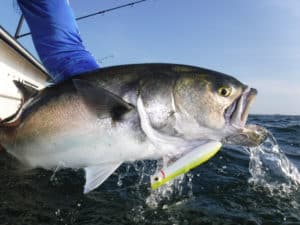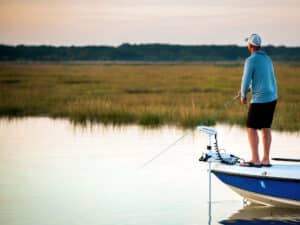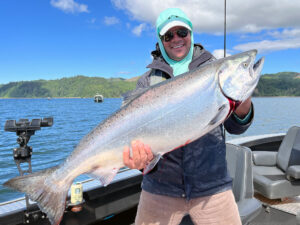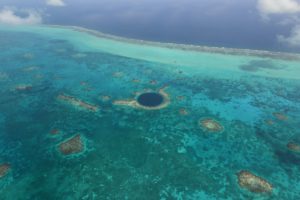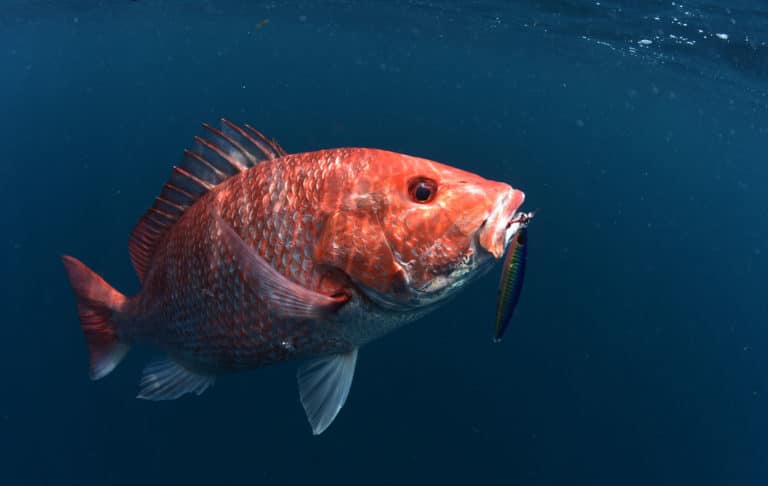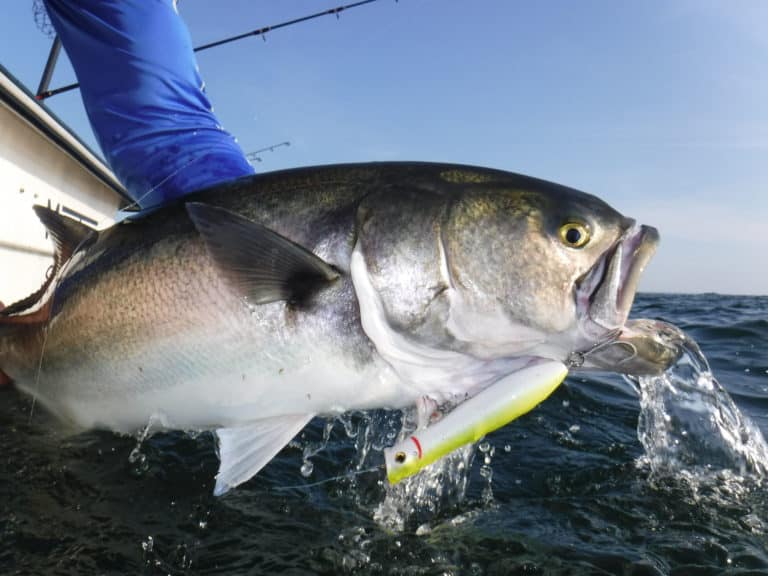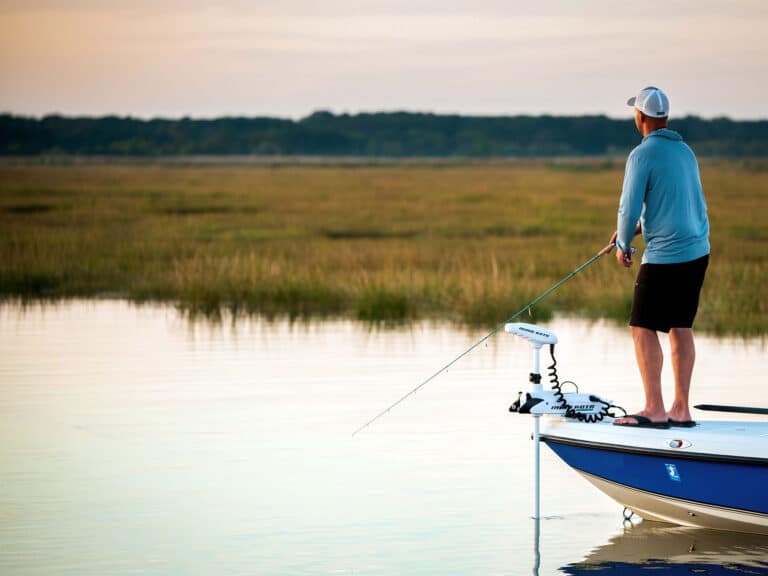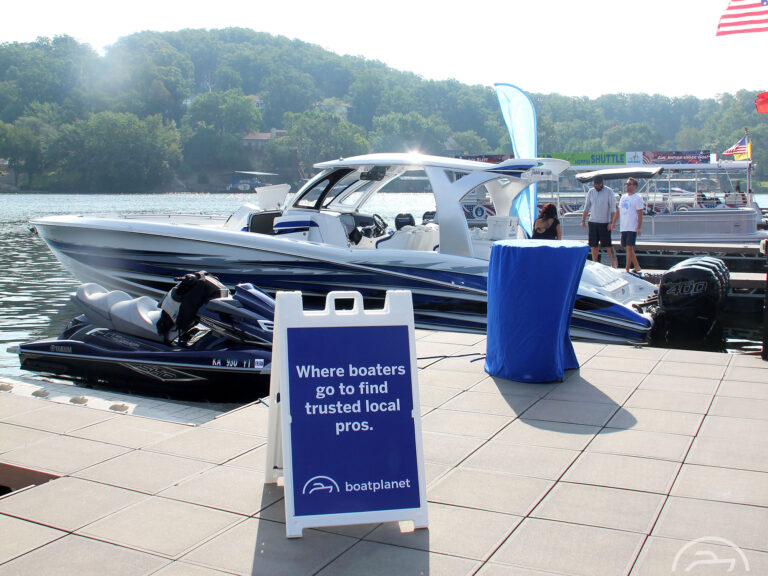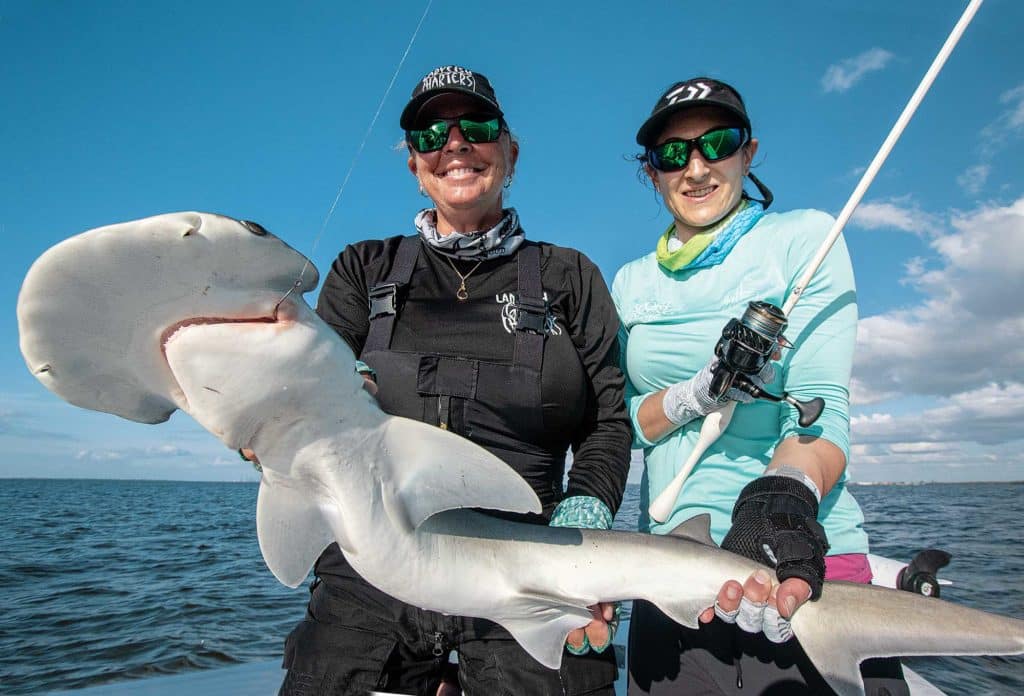
Even as Capt. Lori Hall wrapped the anchor line around a cleat, I cast across a canal a short run from the boat ramp at Simmons Park in Ruskin, Florida. As my Yo-Zuri 3D inshore twitchbait touched down about a foot from the grassy bank, in inches-deep water, I quickly began a jerk-pause retrieve to keep it off the bottom. About three jerks into it, something smashed the lure, and a small snook sailed out of the water. Hardly a trophy, but still, a pretty nice payoff for the first cast of that fall day.
Hall, who runs Ladyfish Charters in Tampa Bay, fishes from Apollo Beach to the Sunshine Skyway Bridge. She had promised we’d find willing snook on the low flood tide, and so we did. That was our main quarry of the morning, and we caught a bunch. The twitchbait proved a hot ticket for quite a few snook—and many missed strikes—while live pilchards (more properly known as scaled sardines) also accounted for plenty of action. Hall’s generous live chumming near the boat certainly didn’t hurt.
Fishing Spots in Tampa Bay
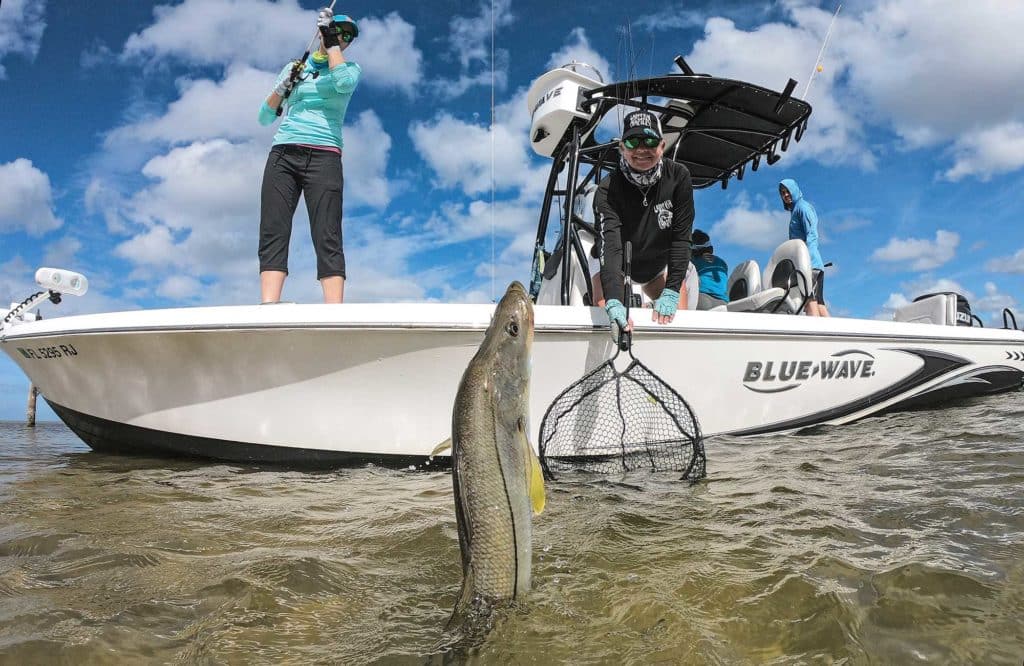
A bit farther south from where we fished is the Terra Ceia Aquatic Preserve, also a great spot for snook. I’ve fished there successfully with angler Jose Chavez, a fishing industry vet, where we caught snook in the virtually hidden openings of creeks and bays.
“That’s one of my favorite areas to fish,” agrees retired guide Capt. Ray Markham, out of St. Petersburg. “The habitat in Terra Ceia has been relatively untouched by development and the encroachment of people, with lush mangroves and oyster bars in the clean water,” Markham says.
With winds light, we switched during the afternoon from fishing mangrove-rimmed bays and canals to drifting grass flats in the open bay in 3 or 4 feet of water. The turtle grass offered a welcome change from many areas of the beleaguered Indian River Lagoon on the east side of the state that I was used to. When it comes to water quality and habitat, Tampa Bay has really cleaned up its act over the past. But Tampa Bay waters do face new water quality issues, as do many parts of Florida.
Over a couple of days, we fished only a small portion of Tampa Bay; I felt we could have spent many days doing so and not have begun to explore even that limited area. In fact, Tampa Bay is Florida’s largest open-water estuary, covering more than 400 square miles. The main shipping channel is a busy place, since Tampa is one of the 10 largest ports in the nation. Fortunately, we remained far from that sort of traffic.
Tarpon Fishing Tampa Bay
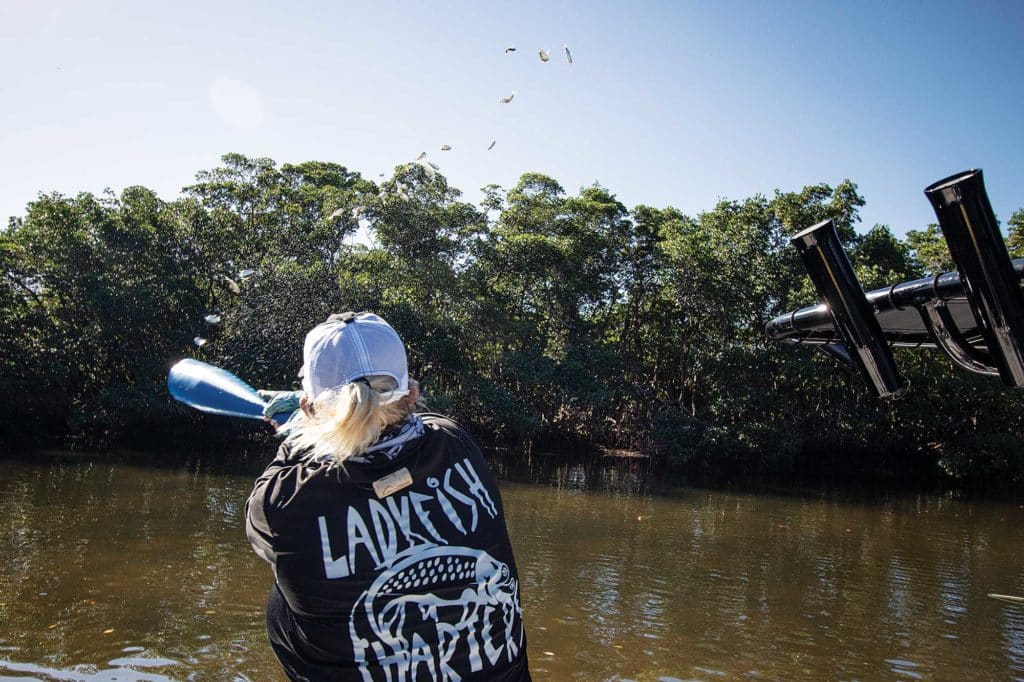
The high flooding tide meant good conditions, and while Hall often finds redfish readily available over these flats, we didn’t locate them that afternoon. But from her high vantage point standing at the Blue Wave’s second station, Hall did spot a big bonnethead shark cruising the shallows, in its typical zigzag fashion, just off the bow.
“Bonnethead, 10 o’clock!” she called out, and my daughter, Rachel, visiting from Virginia, dropped a pilchard just ahead of the fish, about 40 feet out. It looked like the shark would pass nearby but keep moving on when it suddenly turned 90 degrees and pounced on its newfound prize. The circle hook bit where it was supposed to, and the fish offered a real test for a tiny Daiwa with 10-pound braid and St. Croix Legend XTreme Inshore rod, making repeated runs around the boat.
Chavez focuses much of his attention on snook in the lower bay, particularly during outgoing tides, when he works mangrove points, oyster bars, docks and potholes. “Snook basically set up on prime ambush points where there’s a good current,” he says. Find places where water has to funnel through a choke point on an ebb tide, and “you can expect snook to be there waiting for an easy meal.”
Read Next: Tarpon Fishing Tips
As much fun as snook are, Hall—who has been fishing Tampa Bay since the mid-’80s—cites tarpon as her favorite of all the bay’s many gamefish species. And she’s caught some monsters, including “the greatest catch of my life, a 214-pound tarpon.” Once in a while, Murphy takes a nap, as on that day when ESPN happened to be on board filming a show and caught it all.
For tarpon, Markham’s a summertime guy. While even then it can be hit or miss, the action can also be “insane—especially when you see pods of fish coming right at the boat,” he says. “Big-game fishing in the shallows.” Then, he focuses on days around new and full moons when big tides flush crabs and shrimp out of the bays. Similarly, Chavez likes May and June for tarpon, when they might move in by the thousands, he says.
Fishing All Year Long in Tampa Bay
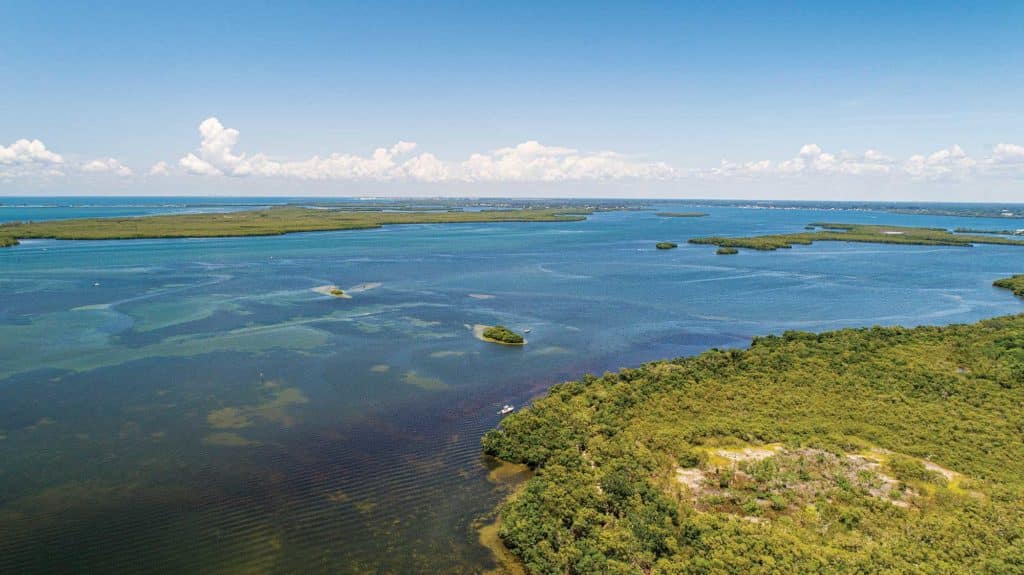
And while Markham is also a snook devotee, he says: “In the fall, I love fishing reds. They can be big and, like bulldogs, they just don’t give up. When the water temperature in the bay drops to between 72 and 78 degrees, with oxygen levels strong, that’s prime topwater time.”
Of course, jacks of various sizes patrol the bay, and when they’re on the attack, can be a blast. They gave us some good battles on our second day out with Hall. Somewhat less likely, a nice flounder surprised one angler. Not many Tampa Bay fishermen target flounder, mostly catching them incidentally, but they’re here. “Find good sand-and-shell or grassy habitat with channels and potholes in moving water, and you’re likely to find flounder much of the year,” Markham says.
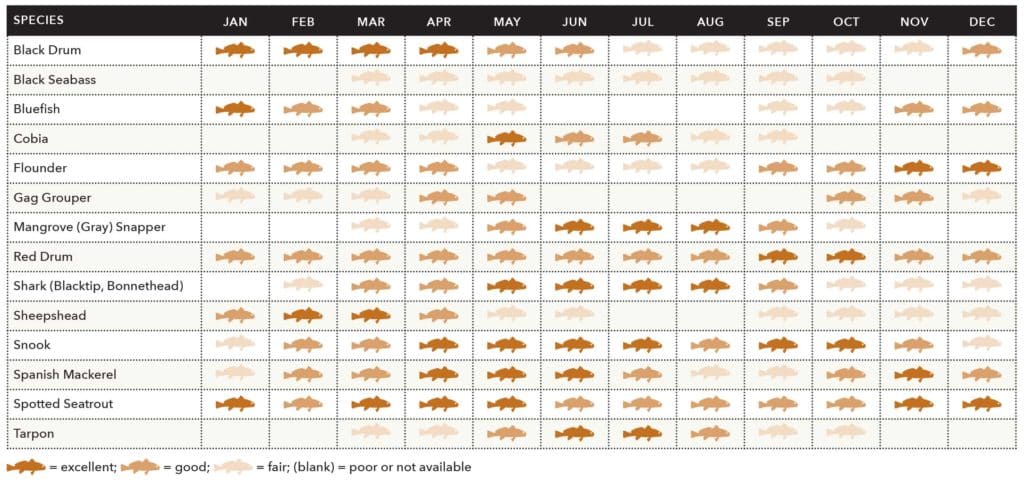
With so much variety when it comes to gamefish species, the bay offers worthwhile action in all seasons. Chavez does indeed fish it year-round but says winter’s his preferred season. That’s when he really likes fishing the negative low tides, “especially during the start of the incoming. That really narrows down the places where the fish can be, and you get to transition up the flat to mangrove shorelines with them as the tide comes in.” Chavez acknowledges that conditions in the dead of winter are often cold and breezy, “but the fishing’s great, and it’s uncrowded because most people don’t want to deal with the discomfort. It really is my favorite time of year.”
Catching Two Redfish at the Same Time
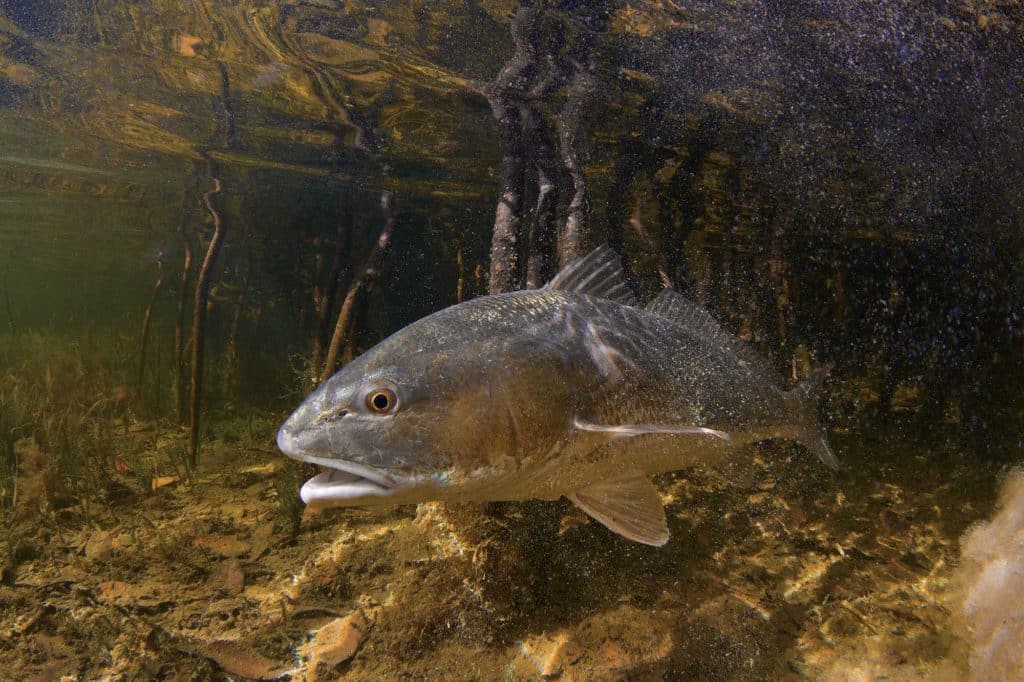
These productive waters harbor many surprises, and Markham recounts his most indelible Tampa Bay memory: “One morning I was fishing a small cove within lower Tampa Bay using ultralight spinning tackle with 6-pound Ande tournament monofilament and a tandem-rigged jig. As I gazed down the shoreline, I saw what looked like a school of huge jack crevalle racing up the shore, eating everything in its path. Mullet were flying, schools of glass minnows were showering, and everything was getting devoured. I waited until the school came just within casting range and made a throw ahead of the lead fish.
“Instantly I was hooked up, and my 70-yard spool of line disappeared at a quick rate. I started the outboard to give chase and get back line. As I did, I got close enough to see that I hadn’t hooked a jack crevalle but a big redfish that looked to be at least 34 inches. When it saw the boat, it bolted back toward the school.
“As I followed it to regain line, the fish caught up to the school, and I felt a big thump on the line. Instantly the fish was ripping off drag again, and then the line went limp and I cranked hard, realizing the fish was running toward the boat.
“That’s when I saw that I now had two fish on my line—and the second fish was even larger. But the tandem rig soon parted, and I was left with only one fish—the larger one. I fought it for another 15 minutes or so before I finally subdued it, taking a measurement before I released her. She was a 46-incher with a massive girth. She bottomed out both scales on my boat, so I don’t know the weight, but to this day it remains the biggest redfish I have ever landed, and on 6-pound tournament mono at that!”
Planning A Fishing Trip to Lower Tampa Bay
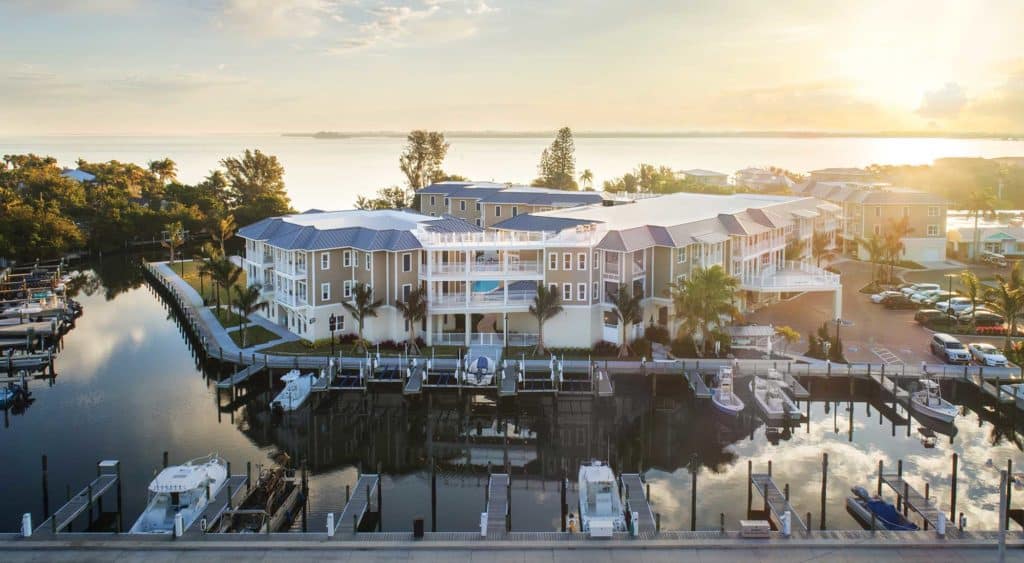
Who: We fished with Capt. Lori Hall, Ladyfish Charters (ladyfishcharters.com, 813-967-5032). Good knowledge, good rig, good gear; easy to recommend. Special kudos to Hall for her people skills—her patience and great sense of humor make her an exceptional guide for families who want to fish the bay.
Where: We stayed on Anna Maria Island, which guards the yawning entrance to Tampa Bay at its southern end, due west of Bradenton. There, we spent several days and nights at Waterline Resort (waterlineresort.com) in one of its Island Suites, and were thoroughly impressed. The suite was provisioned more like a luxury home than a vacation unit, and the kitchen had everything we could possibly want or need. Comfortable and quiet, the suite made us regret having to leave. Also, the resort staff raised “cheery” to a whole new level I hadn’t seen; if these folks don’t truly love their jobs, they’re world-class actors.
More: The Tampa Bay/St. Petersburg area has much to offer for extended trips or larger groups. You can explore it all online at visittampabay.com and visit stpeteclearwater.com.

